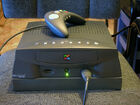No edit summary |
No edit summary |
||
| Line 18: | Line 18: | ||
[[File:Apple STB1 prototype open.jpg|thumb|right|Inside a prototype of the [[Apple Interactive Television Box]], which was cancelled before the Pippin.]] |
[[File:Apple STB1 prototype open.jpg|thumb|right|Inside a prototype of the [[Apple Interactive Television Box]], which was cancelled before the Pippin.]] |
||
*'''Apple Pippin Set-top box:''' Similar to the layout of the early Pippin concept prototype, this unit combined the functionality of a game console with a satellite receiver and [[wikipedia:DVD recordable|DVD-R]] drive. The translucent panel opened to reveal smart card access, [[AppleJack]] and audio connectors.<ref name="Apple-Taktika">[http://www.taktika.com/StudioTaktika/portfolio/pippin_web/pippin_1.htm Apple Pippin Set-top box], Studio Taktika. 2006-06-07.</ref> The processor would have been upgraded to a 120MHz [[PowerPC]] 603 or 603e on an 80MHz bus under the [[Pippin 2.0]] specification.<ref name="macweek-pippin2">[https://web.archive.org/web/19961220043823/http://www.macweek.com/mw_1037/news_pippin.html Options will make Pippin 2 a home, network computer] by David Morgenstern, ''MacWeek'' vol.10-37. 1996-09-30. Archived 1996-12-20.</ref> |
*'''Apple Pippin Set-top box:''' Similar to the layout of the early Pippin concept prototype, this unit combined the functionality of a game console with a satellite receiver and [[wikipedia:DVD recordable|DVD-R]] drive. The translucent panel opened to reveal smart card access, [[AppleJack]] and audio connectors.<ref name="Apple-Taktika">[http://www.taktika.com/StudioTaktika/portfolio/pippin_web/pippin_1.htm Apple Pippin Set-top box], Studio Taktika. 2006-06-07.</ref> The processor would have been upgraded to a 120MHz [[PowerPC]] 603 or 603e on an 80MHz bus under the [[Pippin 2.0]] specification.<ref name="macweek-pippin2">[https://web.archive.org/web/19961220043823/http://www.macweek.com/mw_1037/news_pippin.html Options will make Pippin 2 a home, network computer] by David Morgenstern, ''MacWeek'' vol.10-37. 1996-09-30. Archived 1996-12-20.</ref> |
||
| − | *'''[[Apple Interactive Television Box]] (ITV):''' Not to be confused with a Pippin console, this earlier 68LC040-based set-top box entered into consumer trials in 1994, |
+ | *'''[[Apple Interactive Television Box]] (ITV):''' Not to be confused with a Pippin console, this earlier 68LC040-based set-top box was first prototyped in 1993 and entered into consumer trials in 1994. However, it was cancelled before the Pippin Atmark was released.<ref name="youtube-earlyprototype-1993">[https://www.youtube.com/watch?v=ZVuFTScbZPU An Early Apple Set Top Box Prototype from 1993!] by Mac84, YouTube. 2018-06-08.</ref><ref name="wired-prototype">[https://www.wired.com/2010/05/apple-tv-prototype-sells-on-ebay-for-46-bucks/ Apple TV Prototype Sells on eBay for 46 Bucks] by Brian X. Chen, ''Wired''. 2010-05-05.</ref> |
*'''Arborescence Network Centric computer:''' During Marché international des Inforoutes et du Multimédia '97, [[Groupe Arborescence]] announced a partnership with [[Katz Media]] to develop and market a new Euro-Canadian console based on the [[Katz Media Player 2000|KMP 2000]] for the Canadian market.<ref name="katz-arborescence">[https://web.archive.org/web/19970713040354/http://www.katzmedia.com/presse/cp3b.html Press: Arborescence launches the first Canadian-content Network Centric computer], Katz Media. 1997-05-22. Archived 1997-07-13.</ref> Arborescence also announced what would have been the first "combo" [[Pippin expansion dock]]s with a [[floppy disk|floppy drive]] and [[ethernet]] (or [[Pippin modems|modem]]) through the [[PCI]] bus.<ref name="ogrady-pippin-news">[http://web.archive.org/web/19980207210821/http://ogrady.com:80/pippinnews.stm Arborescence introduce the first COMBO Pippin doc/base module!] by Joe Kudrna, O'Grady's PowerPage: Pippin NewsPage. 1997-08-03. Archived 1998-02-07.</ref> |
*'''Arborescence Network Centric computer:''' During Marché international des Inforoutes et du Multimédia '97, [[Groupe Arborescence]] announced a partnership with [[Katz Media]] to develop and market a new Euro-Canadian console based on the [[Katz Media Player 2000|KMP 2000]] for the Canadian market.<ref name="katz-arborescence">[https://web.archive.org/web/19970713040354/http://www.katzmedia.com/presse/cp3b.html Press: Arborescence launches the first Canadian-content Network Centric computer], Katz Media. 1997-05-22. Archived 1997-07-13.</ref> Arborescence also announced what would have been the first "combo" [[Pippin expansion dock]]s with a [[floppy disk|floppy drive]] and [[ethernet]] (or [[Pippin modems|modem]]) through the [[PCI]] bus.<ref name="ogrady-pippin-news">[http://web.archive.org/web/19980207210821/http://ogrady.com:80/pippinnews.stm Arborescence introduce the first COMBO Pippin doc/base module!] by Joe Kudrna, O'Grady's PowerPage: Pippin NewsPage. 1997-08-03. Archived 1998-02-07.</ref> |
||
| Line 28: | Line 28: | ||
Pippin Atmark-EX front.jpg|Front of a Pippin Atmark-EX shown at [[Macworld Expo]] Tokyo '97. |
Pippin Atmark-EX front.jpg|Front of a Pippin Atmark-EX shown at [[Macworld Expo]] Tokyo '97. |
||
Pippin Atmark-EX back.jpg|Back of a Pippin Atmark-EX with half-size [[PCI]] slot and [[SCSI]] port. |
Pippin Atmark-EX back.jpg|Back of a Pippin Atmark-EX with half-size [[PCI]] slot and [[SCSI]] port. |
||
| − | Apple Pippin prototype set top.gif| |
+ | Apple Pippin prototype set top.gif|Open panel on the front of an Apple Pippin Set-top box prototype. |
| − | Apple Pippin prototype set top 3.gif| |
+ | Apple Pippin prototype set top 3.gif|Colored light indicating smart card status on an Apple Pippin Set-top box prototype.<ref name="Apple-Taktika"/> |
| + | KMP2000+PCI dock.jpg|[[Katz Media Player 2000|KMP 2000]] console with a prototype of a PCI-based [[Pippin Expansion Unit]]. |
||
</gallery> |
</gallery> |
||
Revision as of 19:20, 3 December 2018

A Pippin concept prototype (EVT-1).
Pippin prototypes were assembled by Apple Computer for development before Bandai released its first Pippin Atmark console to consumers in 1996. These rare items are of particular interest to collectors of retro computing.[1] Such systems shipped with developer ROMs, allowing them to run pre-release software without authentication.[2]
Pre-release prototypes
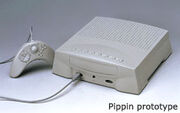
"Power Player" with pre-release AppleJack controller.
- Pippin concept prototype (EVT-1): Constructed by Apple in a large custom black box, this early prototype is more similar to a Power Macintosh computer than a set top console. First unveiled at MILIA '95 at Cannes in January 1995,[3] about 10 units were sent to Japan in October 1995 for testing.[4] A few found their way into auction sites years later.[5]
- Pippin Power Player: The name assigned to demonstration consoles that resembled Bandai's Pippin Atmark, which would publicly debut in Japan on March 28, 1996.[3] Pre-release units were seen without branding and were sometimes modified with cables to attach external SCSI drives.[6] 3,000 Power Players were manufactured for development, of which 500 "monitoring" units were used for market testing.[7]
Unreleased models

Pippin Atmark-PD prototype.
Bandai published specifications for new Pippin models and previewed them Macworld Expo Tokyo '97,[8][9] but these were never released for sale.
- Pippin Atmark-PD: Designed as a direct replacement of the original Atmark footprint, it would have included an internal drive that could read a standard CD-ROM disc, as well as read/write to a Phase-change Dual (PD) disk with 600 MB of rewritable optical storage capacity.[10] An external SCSI port would have allowed additional devices to be connected, or for the console itself to function as an external PD drive for a computer.[11] The price of a standalone PD drive was about JP¥ 60,000-70,000 at the time.[9]
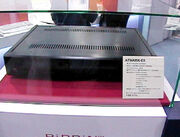
Pippin Atmark-EX prototype.
- Pippin Atmark-EX: Featuring a footprint similar to a Macintosh desktop unit, it was designed with 8MB of RAM, expandable to 40MB with standard 72-pin EDO-DRAM modules instead of proprietary Pippin memory modules. The CD-ROM drive was upgraded to a 8x speed. The chassis could handle a half-sized PCI card internally. The displayed unit contained a PCI-based ethernet interface, a built-in analog modem, and wireless infrared (IR) Apple Desktop Bus.[12][13] Expected price estimated to be about JP¥ 100,000.[9]
Other unreleased models include:
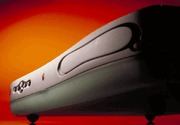
The design of this unreleased set-top box resembled the early Pippin prototype.
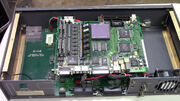
Inside a prototype of the Apple Interactive Television Box, which was cancelled before the Pippin.
- Apple Pippin Set-top box: Similar to the layout of the early Pippin concept prototype, this unit combined the functionality of a game console with a satellite receiver and DVD-R drive. The translucent panel opened to reveal smart card access, AppleJack and audio connectors.[14] The processor would have been upgraded to a 120MHz PowerPC 603 or 603e on an 80MHz bus under the Pippin 2.0 specification.[15]
- Apple Interactive Television Box (ITV): Not to be confused with a Pippin console, this earlier 68LC040-based set-top box was first prototyped in 1993 and entered into consumer trials in 1994. However, it was cancelled before the Pippin Atmark was released.[16][17]
- Arborescence Network Centric computer: During Marché international des Inforoutes et du Multimédia '97, Groupe Arborescence announced a partnership with Katz Media to develop and market a new Euro-Canadian console based on the KMP 2000 for the Canadian market.[18] Arborescence also announced what would have been the first "combo" Pippin expansion docks with a floppy drive and ethernet (or modem) through the PCI bus.[19]
Gallery
References
- ↑ (Prototype) Apple Pippin by Pierre Dandumont, Le journal du Lapin (French). 2013-04-26.
- ↑ Les ROMs de la Pippin by Pierre Dandumount, Le Journal du Lapin (French). 2016-07-02.
- ↑ 3.0 3.1 Bandai Pippin Image Archive, The Mac Geek.
- ↑ Apple Pippin Prototype, ASSEMblergames. 2013-03-17. Archived 2014-11-04.
- ↑ Un prototype de Pippin sur eBay by Pierre Dandumont, Le journal du Lapin (French). 2016-12-11.
- ↑ Macworld Tokyo: Of Cameras and Macs by Chuck and Linda Shotton, Tidbits. 1997-03-03.
- ↑ 9.0 9.1 9.2 Pippinは元気です! From B.D.E by 松山由美子, MacWeek / Japan. 1997-02-20. Archived 1998-12-01.
- ↑ Atmark-PD (Japanese), Bandai Digital Entertainment. Archived 1997-10-25.
- ↑ Atmark-PD (Japanese), Atmark Channel. Archived 1997-06-29.
- ↑ Atmark-EX (Japanese), Bandai Digital Entertainment. Archived 1997-10-25.
- ↑ Atmark-EX (Japanese), Atmark Channel. Archived 1997-06-29.
- ↑ 14.0 14.1 Apple Pippin Set-top box, Studio Taktika. 2006-06-07.
- ↑ Options will make Pippin 2 a home, network computer by David Morgenstern, MacWeek vol.10-37. 1996-09-30. Archived 1996-12-20.
- ↑ An Early Apple Set Top Box Prototype from 1993! by Mac84, YouTube. 2018-06-08.
- ↑ Apple TV Prototype Sells on eBay for 46 Bucks by Brian X. Chen, Wired. 2010-05-05.
- ↑ Press: Arborescence launches the first Canadian-content Network Centric computer, Katz Media. 1997-05-22. Archived 1997-07-13.
- ↑ Arborescence introduce the first COMBO Pippin doc/base module! by Joe Kudrna, O'Grady's PowerPage: Pippin NewsPage. 1997-08-03. Archived 1998-02-07.
External links
- Un prototype de Pippin dans ma collection at Le Journal du Lapin (French, 2018-01-31)
- Prototype bandai Pippin controller? at YouTube
- Apple Pippin: Unfulfilled roadmap at Wikipedia





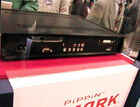

![Apple Pippin prototype set top 3.gif (150 KB) Colored light indicating smart card status on an Apple Pippin Set-top box prototype.[14]](https://static.wikia.nocookie.net/pippin/images/a/af/Apple_Pippin_prototype_set_top_3.gif/revision/latest/scale-to-width-down/140?cb=20170501194553)
